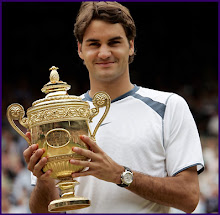 The Serb has beefed up his game. Here are two ways to help you do the same.
The Serb has beefed up his game. Here are two ways to help you do the same.
1. Take your chances. Novak Djokovic has a lot of the ingredients that make some players superstars. He’s athletic; he can play offensively; he knows how to take the ball early; he’s not afraid to end points at the net; he’s a good competitor; and he can hurt you with both his forehand and his backhand. In other words, he’s a pretty darn good tennis player. Along with Andy Murray and Richard Gas-quet, Djokovic is on his way to the upper echelon of the game.
The thing I think Djokovic has done especially well in the last 12 to 18 months is hone his offensive mind-set. He’s gotten much better at recognizing and taking advantage of his opportunities to be aggressive. For Djokovic, that typically means blasting his big, fl at backhand down the line. He also uses his huge forehand to open up the court so he either can get to the net and finish the point with a volley or set up a short ball that he can put away with his next ground stroke.
Seeing and seizing your chances to take charge are skills that you can use to improve your game as well. To learn when you should attack off the ground, try this drill: Start by rallying from the backcourt. Whenever you get at least one foot inside the baseline, you must hit an offensive shot—either go for a winner or hit a shot you can follow to net. You may miss a lot of balls at first, but you’ll soon start to be aware of your position on the court and learn to select the right shot at the right time to take advantage of your edge. Play one game to 11 points.
2. Neutralize with slice. Although Djokovic is a tall, aggressive player, he’s athletic and defends well. He’s particularly skilled at using a one-handed backhand slice—he also has a two-handed drive—as a neutralizing shot when he’s pulled wide. This means that when his opponent hits a tough shot, he counters it by fl oat-ing the ball back deep, forcing his opponent to hit one or two more shots. Many players with two-handed back-hands, especially at the club level, try to hit with both hands when they’re on the run. That’s difficult. At the rec level, having a solid defensive slice can pay big dividends.
To improve this skill, even if you don’t have a one-handed backhand, try this exercise: Rally crosscourt, forehand to forehand. When one player gets a short ball, he has to hit it aggressively down the line to his opponent’s backhand. The defender has to try to use the deep slice to get back into the point with the goal of regaining the offensive as soon as possible. The person on the attack must wait for the slice reply before moving forward so he can work on his offense if the slice is short. (To do this drill in a lefty-righty pairing, the player hit-ting backhands has to attack down the line when he gets a short ball.) Play one game to 11.


No comments:
Post a Comment